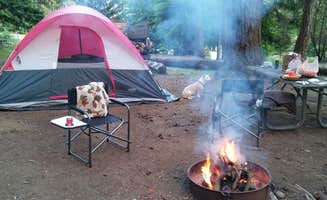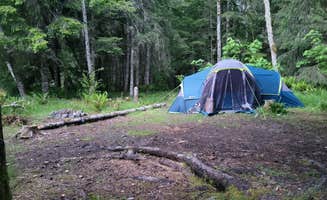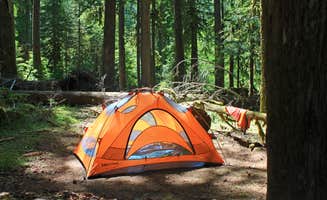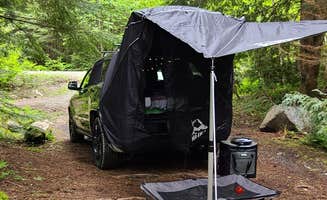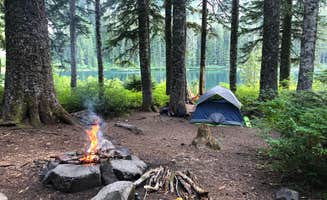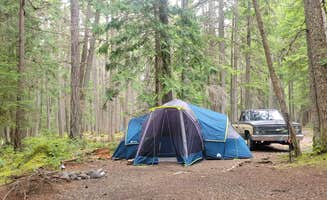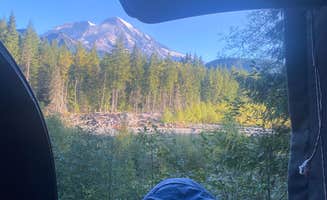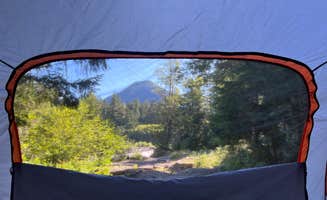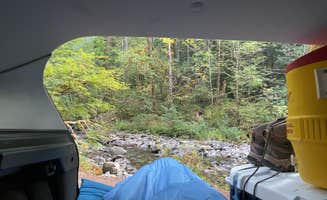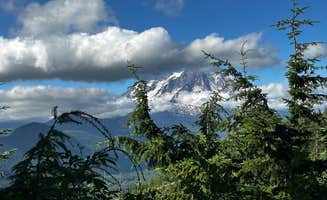Dispersed camping areas near Milton, Washington are primarily concentrated in the Mount Baker-Snoqualmie and Gifford Pinchot National Forests at elevations ranging from 1,500 to 3,000 feet. These free sites typically see heavy snow from November through April, making summer and early fall the most accessible seasons. Higher elevation areas may require high-clearance vehicles to navigate washboarded roads that deteriorate throughout the camping season.
What to do
Hiking trails access: Ipsut Creek Camp offers multiple day hiking options from the main campground. One reviewer noted, "The trail was covered in wildflowers, cairns, creeks and mini waterfalls. It made for a beautiful day trip out of camp with plenty of opportunities to go further into the backcountry."
Swimming spots: At Forest Road 7300 Pull-Off, campers can find "great creekside campsites along Huckleberry Creek with small swimming spots and fire pits to enjoy." This area provides natural water access during summer months when temperatures climb.
Fishing opportunities: Joemma Beach State Park Campground features a "long dock in the area where you can go fishing. You can walk along the beach as well," according to a recent visitor. The park's waterfront location makes it popular for anglers.
What campers like
River soundscapes: The White River Dispersed Camping area receives consistent praise for its natural ambiance. One camper mentioned, "A little road noise but it's drowned out by the sound of the creek," while another added that sites offer "the soothing, constant sound of the roaring White River nearby."
Solitude options: For those seeking privacy at South Fork Snoqualmie River, reviewers recommend perseverance: "If you keep going down the road you'll find plenty of quiet and private places." This strategy applies to most dispersed areas near Milton.
Nature viewing: Wildlife sightings enhance the camping experience. At Joemma Beach State Park, a camper reported, "We did spot a bald eagle early in the morning," while multiple sites offer opportunities to see deer and smaller forest animals during quieter hours.
What you should know
Fire restrictions: Fire bans are common during dry months. A visitor to Forest Road 7300 Pull-Off noted: "There was a fire ban during our stay but there are many fire pits at each site." Always check current restrictions before planning campfires.
Weekend crowds: Free camping near Milton fills quickly on weekends. A South Fork Snoqualmie River camper advised: "We left Friday evening and most spots were taken," suggesting Thursday arrivals for prime locations.
Bridge closures: Road access changes seasonally. A Carbon River visitor warned: "I go every year, but unfortunately the only bridge to gain access to camping is closed until further notice." Always check Forest Service websites for current closures before traveling.
Insect considerations: Bug activity intensifies near water. A White River camper mentioned: "Bugs weren't too bad," but others report mosquito problems, particularly in stagnant water areas during summer months.
Tips for camping with families
Safety precautions: Some areas have natural hazards. One camper cautioned about the Tinkham Road area, saying "be very cautious as near one of the camp sites are very dangerous plants that are fatal and they are lined all around the campground so not recommended if you have children."
Campsite selection: At Ranger Creek Airstrip, families can find "lots and lots of other campers there," which provides both community and noise. The unique setting offers educational opportunities as "This is an airstrip, the planes are quiet so you don't really hear them coming in. But hurry up and get a show if you hear them for take off!!"
Food storage: Wildlife interactions require proper precautions. A reviewer at Ranger Creek Airstrip Dispersed advised: "I strongly suggest you have a way to secure your food and trash as there are lots of squirrels and raccoons."
Tips from RVers
Road condition awareness: Access roads vary significantly in quality. For White River Dispersed Camping, a reviewer warned: "The road can be a bit thin, so I would be careful with extra large vehicles. It is also a bit of a challenging road, so low clearance vehicles wouldn't be treated well."
Site selection for larger rigs: Larger RVs should target specific areas. At Ranger Creek Airstrip, an experienced RVer recommended: "For larger rigs - take the second left at a Y-intersection, and then keep to the left and you won't have any trouble getting in. Going to the right at the Y takes you to an area that big rigs might have trouble finding spots or turning around."
Offseason advantages: Timing dramatically impacts the experience. A Ranger Creek visitor observed: "Best in late fall when it's cooler. Less loud drunkards. Can fit large RV's down a half mile rough road. I have been a few times in october/November in a 40 ft 5er."


